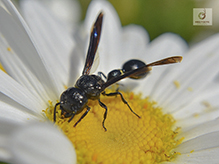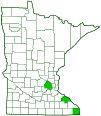Mason wasp
(Zethus spinipes ssp. spinipes)
Conservation • Description • Habitat • Ecology • Distribution • Taxonomy
Conservation Status |
|||
| IUCN Red List | not listed |
||
| NatureServe | not listed |
||
| Minnesota | not listed |
||
Description
There are 30 species of mason wasps in the genus Zethus. Only six occur in North America north of Mexico. Five of these are restricted to the southernmost states. Only one species, Zethus spinipes, occurs in Minnesota. There are two subspecies of Zethus spinipes, but only one subspecies occurs in Minnesota.
Zethus spinipes ssp. spinipes is a common, solitary, mason wasp. It occurs in the northern United States east of the Great Plains and in southern Ontario Canada. It is uncommon in Minnesota.
Adults are small and black with just a few ivory markings. The front part of the body (mesosoma) is connected to the rear part (metasoma) by narrow waist (petiole). Females have a ½″ to 9⁄16″ (12 to 14 mm) forewing length. Males are smaller, with a ⅜″ to 7⁄16″ (9.5 to 11 mm) forewing length.
The head is black. There are two large compound eyes, one on each side of the head, and three small simple eyes (ocelli) in a triangular pattern at the top of the head between the compound eyes. The antennae are thread-like. On the male they have just 12 segments, are jointed (elbowed), and the long first segment (scape) is ivory on the underside. On the female they have 13 segments, are not elbowed, and are entirely black. On both sexes there is a ivory spot on the head at the base of each antenna. The spot is small but distinct on the male, much smaller on the female. The cheek (gena) tapers nearly to a point at the bottom. The jaws (mandibles) are long and knife-like. The plate on the face (clypeus) is pale ivory on the male, black on the female. The bottom margin of the clypeus is more or less straight. It does not extend below the level of the lower margin of the compound eye.
The thorax is black and has three segments. However, the first segment of the abdomen is fused to the thorax, giving the thorax the appearance of having four segments. The upper plate on the first segment (pronotum) is short, collar-like, and entirely black. The plate at the base of each wing (tegula) is black and long, twice as long as wide. The second segment of the thorax (scutum), by far the largest, is entirely black on both sexes. On the male the third segment has a pair of ivory spots. On the female it is entirely black. The first and second abdominal segments form a petiole that connect the abdomen to the thorax.
The first segment of the metasoma is twice as long as wide and only half as wide as the second segment. It is black with a ivory band at the end. The second segment is larger than the remaining segments combined. It is constricted at the base into a second petiole. The constricted portion is no more than half as wide as the first segment. Zethus is one of only two genera in the family Eumeninae that have a narrowly contracted (petiolate) first segment of the mesosoma. There is a narrow ivory band at the end of the second segment.
The wings are smoky brown. On the forewing, the first discoidal cell is very long, about half the total length of the wing. The first subdiscal cell (sd) does not touch the marginal cell (m). There are three submarginal cells. At the base of the second submarginal cell there are two distinct kinks, forming a dogleg in the M vein.
The legs are black. The fourth segment (tibia) of the middle leg has a single spur at the tip. The last part of the leg (tarsus), corresponding to the foot, has five segments. There is a pair of claws at the tip of each tarsus. The claws are split (cleft) at the end.
Size
Female forewing length: ½″ to 9⁄16″ (12 to 14 mm)
Male forewing length: ⅜″ to 7⁄16″ (9.5 to 11 mm)
Similar Species
Habitat
Ecology
Season
Behavior
When at rest, the wings are folded longitudinally over the body.
Life Cycle
The female may nest in an abandoned burrow of another insect, or build a nest from vegetable matter and resin. It does not create a clay “pot”.
Larva Food/Hosts
Adult Food
Distribution |
||
|
Sources |
|
| 10/7/2025 | ||
Occurrence |
||
|
||
Taxonomy
Order
Hymenoptera (Ants, Bees, Wasps, and Sawflies)
Suborder
Apocrita (Narrow-waisted Wasps, Ants, and Bees)
Infraorder
Aculeata (ants, bees, and stinging wasps)
Superfamily
Vespoidea (vespoid wasps)
Family
Vespidae (hornets, paper wasps, potter wasps, and allies)
Subfamily
Eumeninae (potter and mason wasps)
Genus
Zethus
Subgenus
Zethus
Species
Zethus spinipes
Subordinate Taxa
Synonyms
Common Names
This species has no common name. The common name of the Family Eumeninae is potter and mason wasps. Zethus spinipes is a mason wasp, and that common name is used here for convenience.
Glossary
Clypeus
On insects, a hardened plate on the face above the upper lip (labrum).
Gena
In insects: The area between the compound eye and the mandible; the cheek. In birds: The area between the the angle of the jaw and the bill; the feathered side (outside) of the under mandible. Plural: genae.
Mesosoma
In Hymenoptera: the front part of the body, consisting of all three segments of the thorax and the first segment of the abdomen, to which the wings are attached.
Metasoma
In Hymenoptera: the armored rear part of the body, consisting of the second segment of the abdomen and all segments posterior to it.
Ocellus
Simple eye; an eye with a single lens. Plural: ocelli.
Pronotum
The exoskeletal plate on the upper side of the first segment of the thorax of an insect.
Scape
In plants: An erect, leafless stalk growing from the rootstock and supporting a flower or a flower cluster. In insects: The basal segment of the antenna.
Scutum
The forward (anterior) portion of the middle segment of the thorax (mesonotum) in insects and some arachnids.
Tarsus
On insects, the last two to five subdivisions of the leg, attached to the tibia; the foot. On spiders, the last segment of the leg. Plural: tarsi.
Tegula
A small, hardened, plate, scale, or flap-like structure that overlaps the base of the forewing of insects in the orders Lepidoptera, Hymenoptera, Diptera, and Homoptera. Plural: tegulae.
Tibia
The fourth segment of an insect leg, after the femur and before the tarsus (foot). The fifth segment of a spider leg or palp. Plural: tibiae.
Visitor Photos
Share your photo of this insect.
This button not working for you?
Simply email us at info@MinnesotaSeasons.com.
Attach one or more photos and, if you like, a caption.
|
||
Mike Poeppe |
 |
MinnesotaSeasons.com Photos
|

Slideshows

Visitor Videos
Share your video of this insect.
This button not working for you?
Simply email us at info@MinnesotaSeasons.com.
Attach a video, a YouTube link, or a cloud storage link.
Other Videos



